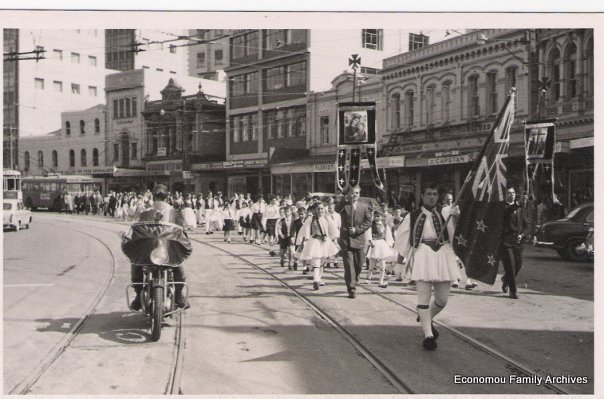Agion Oros - The Holy Mountain
(Picture Source: Wikipedia - Gabriel )
A rare chance for most of us to visit the Holy Mountain - Mt Athos in Greece - via our television screens tonight, for those with access to CBS, when the MT Athos story was broadcast on "60 Minutes" on Easter Sunday, April 24 2011, thanks to producer, Global Greek Michael Karzis and his fellow producer Harry Radliffe.
For the women amongst us, it is probably their only chance to get an inside glimpse of this all male bastion since access to the Holy Mountain for women is forbidden despite many protests over the years, including a more formal one from the EU in 2003.
A place that is visited by many Christians from all over the world including world leaders, kings, and princes, Mt. Athos was created by ancient Byzantine emperors to be the spiritual capital of Orthodox Christianity,and for millions of Orthodox Christians it is the most sacred place on Earth.
After two years of negotiating, Bob Simon and a team from "60 Minutes" were given unprecedented access to document monastic life on Mt. Athos - which is also known as the The Garden of the Mother of God - To Perivoli tis Panagias. The result is a portrait of a place and a Christian community that hasn't changed much in a thousand years that most people, other than Orthodox Christians, have ever seen.
There are 2,000 Athonite monks living in what is the most unique monastery complex in the world; most pray all day. Some monks even told Simon that they pray while they sleep - and they only get about three hours of sleep a night. The monks divide their day into three parts: They spend about eight hours a day in church, and when they're not resting their time is dedicated to the work needed to keep the 20 monasteries running. Mt. Athos is also beautiful and has probably changed less than any other inhabited place on the planet. Some of the monasteries here are perched high on cliffs above the Aegean Sea, with sylvan hills as a backdrop and architecture that could have come out of a medieval fairytale. It was the architecture that first attracted a young boy from Winthrop, Mass.
"It was just so impressive and I turned around and I said to him, 'Dad, you know, I don't think I am going to believe that somebody lives in that building until I step on those balconies myself,"
says Fr. Iakovos, one of three monks originally from the U.S. who Simon speaks to, in addition to others from around the world. He came to Mt. Athos 25 years ago and he points out that it's not just the way of life that hasn't changed, neither has the Divine Liturgy that the monks celebrate every day.
"You have to understand, the words that we are saying in today's liturgy are the same words Christ was saying, are the same words that saints from the first century, the second century, the third century, the fourth century," he tells Simon.
Over the last millennium, the 20 monasteries here have been a repository for sacred treasures and religious relics that date back to the days of the Byzantine Empire. Father Matthew, from Fond du Lac, Wis., was given special permission by the abbot of Vatopedi Monastery to show Simon just a few of the almost 4,000 religious icons stored there, the highlight, a restored icon of Christ dating from the 14th century.
These priceless artifacts are kept behind lock and key and are rarely seen by pilgrims or even the monks themselves. The lock system was ancient and extraordinary. It requires four separate keys to unlock the door to the inner sanctum, and normally takes at least two monks to unlock the door, because no one monk is allowed to have all four keys at the same time. Simon describes it as,
"a medieval version of the nuclear launch control."
The rare treasures on Mt. Athos have attracted many invaders over the centuries. Fr Maximos, a former professor at the Harvard Divinity School who is from Long Island, N.Y., told Simon that in World War II in 1941, German forces were about to invade the peninsula. The monks met with German officers who told them the only way to save themselves was to make a direct appeal to Hitler. The monks wrote a letter and asked Hitler to place the Holy Mountain under his personal protection. Fr. Maximos tells Simon,
"It seems that Hitler liked the idea and accepted the invitation to become the personal protector of the Holy Mountain."
Hitler's plan was to loot the sacred treasures though, and he sent an advance team of academics to photograph and catalogue almost everything on the Holy Mountain. In the end, not a thing was ever taken - no one really knows why - possibly divine intervention.
Most monks today consider the Nazi episode a small blip on the road - after all, the monks there have been devoting their lives to prayer for 1,000 years. They say they try to get as close to God as humanly possible.
Fr. Nikandros, from Melbourne, Australia, says their monastic life also serves another mission - as frontline warriors in the battle of good versus evil.
"We fight against the angels of the dark side, you see - of the devil - Satan," he tells Simon...





No comments:
Post a Comment
We welcome feedback from our readers, but please keep your comments polite and respectful. Anonymous comments will be evaluated and published only if considered appropriate.